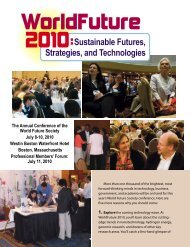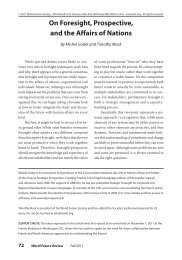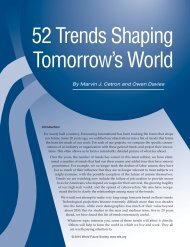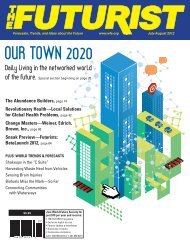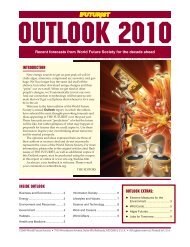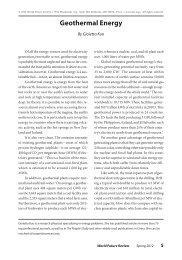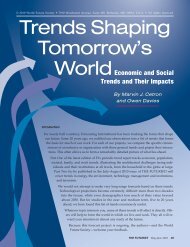May-June 2008 article in THE FUTURIST (PDF) - World Future Society
May-June 2008 article in THE FUTURIST (PDF) - World Future Society
May-June 2008 article in THE FUTURIST (PDF) - World Future Society
Create successful ePaper yourself
Turn your PDF publications into a flip-book with our unique Google optimized e-Paper software.
Bioviolence:<br />
A Grow<strong>in</strong>g<br />
Threat<br />
By Barry Kellman<br />
Biological technologies<br />
that were once at the<br />
furthest frontiers of<br />
science will — <strong>in</strong> the next<br />
decade — become<br />
available to anyone with a<br />
modicum of scientific<br />
tra<strong>in</strong><strong>in</strong>g. An <strong>in</strong>ternational<br />
law expert proposes a<br />
global security fix.<br />
GREMLIN / ISTOCKPHOTO.COM<br />
<strong>THE</strong> <strong>FUTURIST</strong> <strong>May</strong>-<strong>June</strong> <strong>2008</strong> www.wfs.org 25
© <strong>2008</strong> <strong>World</strong> <strong>Future</strong> <strong>Society</strong> • 7910 Woodmont Avenue, Suite 450, Bethesda, MD 20814, U.S.A. • All rights reserved.<br />
loom<strong>in</strong>g danger confronts the<br />
A world—the threat of bioviolence.<br />
It is a danger that will only grow <strong>in</strong><br />
the future, yet we are <strong>in</strong>creas<strong>in</strong>gly<br />
fail<strong>in</strong>g to confront it. With every<br />
pass<strong>in</strong>g day, committ<strong>in</strong>g a biocatastrophe<br />
becomes a bit easier, and this<br />
condition will perpetuate for as long<br />
as science progresses.<br />
Biological warfare is as old as conflict,<br />
of course, but <strong>in</strong> terms of the<br />
objectives of traditional warfare—<br />
ga<strong>in</strong><strong>in</strong>g territory or resources, compell<strong>in</strong>g<br />
the surrender of an oppos<strong>in</strong>g<br />
army—biological weapons weren’t<br />
very effective. If the objective is to<br />
<strong>in</strong>flict mass death and panic on a<br />
mixed population, however, emerg<strong>in</strong>g<br />
bioweapons offer remarkable potential.<br />
We would be irresponsible to<br />
presume that radical jihadists like al-<br />
Qaeda have ignored said potential.<br />
What’s New <strong>in</strong> Bioviolence?<br />
Bioviolence refers to the many ways<br />
to <strong>in</strong>flict disease as well as the many<br />
people who might choose to do so,<br />
whether heads of states, crim<strong>in</strong>als, or<br />
fanatics. Fortunately, do<strong>in</strong>g bioviolence<br />
is technically far more difficult<br />
than us<strong>in</strong>g conventional explosives.<br />
Natural pathogens like anthrax are<br />
difficult to weaponize. Smallpox rema<strong>in</strong>s<br />
unavailable (presumably);<br />
plague is readily treatable; Ebola<br />
kills too quickly to ignite a pandemic.<br />
But emerg<strong>in</strong>g scientific discipl<strong>in</strong>es—notably<br />
genomics, nanotechnology,<br />
and other microsciences—<br />
could alter these pathogens for use<br />
as weapons. These scientific discipl<strong>in</strong>es<br />
offer profound benefits for humanity,<br />
yet there is an om<strong>in</strong>ous security<br />
challenge <strong>in</strong> m<strong>in</strong>imiz<strong>in</strong>g the danger<br />
of their hostile application.<br />
For example, highly dangerous<br />
agents can be made resistant to vacc<strong>in</strong>es<br />
or antibiotics. In Australia, scientists<br />
<strong>in</strong>troduced a gene <strong>in</strong>to mousepox<br />
(a cous<strong>in</strong> of smallpox) to reduce<br />
pest populations—it worked so well<br />
that it wiped out 100% of affected<br />
mice, even those that had immunity<br />
aga<strong>in</strong>st the disease. Various bacterial<br />
agents, such as plague or tularemia<br />
(rabbit fever), could be altered to <strong>in</strong>crease<br />
their lethality or to evade antibiotic<br />
treatment.<br />
Diseases once thought to be eradicated<br />
can now be resynthesized, en-<br />
26 <strong>THE</strong> <strong>FUTURIST</strong> <strong>May</strong>-<strong>June</strong> <strong>2008</strong> www.wfs.org<br />
abl<strong>in</strong>g them to spread <strong>in</strong> regions<br />
where there is no natural immunity.<br />
The polio virus has been synthesized<br />
from scratch; its creators called it an<br />
“animate chemical.” Soon, it may be<br />
resynthesized <strong>in</strong>to a form that is contagious<br />
even among vacc<strong>in</strong>ated populations.<br />
Recreation of longeradicated<br />
livestock diseases could<br />
ravage herds severely lack<strong>in</strong>g <strong>in</strong> genetic<br />
diversity, damage food supplies,<br />
and cause devastat<strong>in</strong>g economic<br />
losses.<br />
Perhaps the greatest biothreat is<br />
the manipulation of the flu and other<br />
highly contagious viruses, such as<br />
Ebola. Today, scientists can change<br />
parts of a virus’s genetic material so<br />
that it can perform specific functions.<br />
The genomic sequence of the Spanish<br />
flu virus that killed upwards of<br />
40 million people nearly a century<br />
ago has been widely published; any<br />
savvy scientist could reconstruct it.<br />
The avian flu is even more lethal, albeit<br />
not readily contagious via casual<br />
aerosol delivery. A malevolent bioscientist<br />
might augment its contagiousness.<br />
The Ebola virus might be<br />
manipulated so that it kills more<br />
slowly, allow<strong>in</strong>g it to be spread farther<br />
before its debilitat<strong>in</strong>g effects altogether<br />
consume its carrier. A bit<br />
further off is genetic manipulation of<br />
the measles virus—one of the great<br />
killers <strong>in</strong> human history—render<strong>in</strong>g<br />
useless the immunizations that most<br />
of us receive <strong>in</strong> early childhood.<br />
Soon, laboratory resynthesis of<br />
smallpox may be possible.<br />
Advanced drug delivery systems<br />
can be used to dissem<strong>in</strong>ate lethal<br />
agents to broad populations. Bioregulators—small<br />
organic compounds<br />
that modify body systems—<br />
could enhance targeted delivery<br />
technologies. Some experts are concerned<br />
that new weapons could be<br />
aimed at the immune, neurological,<br />
and neuroendocr<strong>in</strong>e systems. Nanotechnology<br />
that lends itself to mechanisms<br />
for advanced disease detection<br />
and drug delivery—such as gold<br />
nanotubes that can adm<strong>in</strong>ister drugs<br />
directly <strong>in</strong>to a tumor—could also deliver<br />
weaponized agents deep <strong>in</strong>to<br />
the body, substantially rais<strong>in</strong>g the<br />
weapon’s effectiveness.<br />
Altogether, techniques that were<br />
on the frontiers of science only a decade<br />
or two ago are rapidly mutat<strong>in</strong>g<br />
as progress <strong>in</strong> the biological sciences<br />
enables new ways to produce lethal<br />
catastrophe. Today, they are on the<br />
horizon. With<strong>in</strong> a decade, they will<br />
be pedestrian. Accord<strong>in</strong>g to the National<br />
Academies of Science, “The<br />
threat spectrum is broad and evolv<strong>in</strong>g—<strong>in</strong><br />
some ways predictably, <strong>in</strong><br />
other ways unexpectedly. In the future,<br />
genetic eng<strong>in</strong>eer<strong>in</strong>g and other<br />
technologies may lead to the development<br />
of pathogenic organisms<br />
with unique, unpredictable characteristics.”<br />
For as far <strong>in</strong>to the future as we can<br />
possibly see, every pass<strong>in</strong>g day it becomes<br />
slightly easier to commit a<br />
vio lent catastrophe than it was the<br />
day before. Indeed, the rapid pace of<br />
advanc<strong>in</strong>g science helps expla<strong>in</strong> why<br />
policies to prevent such a catastrophe<br />
are so complicated.<br />
Bioviolence Jihad?<br />
Some experts argue that terrorists<br />
and fanatics are not <strong>in</strong>terested <strong>in</strong> bioviolence<br />
and that the danger might<br />
therefore be overblown. S<strong>in</strong>ce there<br />
have been no catastrophic bioviolence<br />
attacks, these experts argue,<br />
terrorists lack the <strong>in</strong>tention to make<br />
bioweapons. Hopefully, they are correct.<br />
But an enormous amount of evidence<br />
suggests they are wrong. From<br />
the dawn of biology’s ability to isolate<br />
pathogens, people have pursued<br />
hostile applications of biological<br />
agents. It is perilous to ignore this<br />
extensive history by presum<strong>in</strong>g that<br />
today’s villa<strong>in</strong>s are not fervent about<br />
weaponiz<strong>in</strong>g disease.<br />
Not a s<strong>in</strong>gle state admits to hav<strong>in</strong>g<br />
a bioweapons program, but U.S. <strong>in</strong>telligence<br />
officials assert that as<br />
many as 10 states might have active<br />
programs, <strong>in</strong>clud<strong>in</strong>g North Korea,<br />
Iran, and Syria. Moreover, many terrorist<br />
organizations have expressed<br />
<strong>in</strong>terest <strong>in</strong> acquir<strong>in</strong>g biological weapons.<br />
Whatever weight the taboo<br />
aga<strong>in</strong>st <strong>in</strong>flict<strong>in</strong>g disease might have<br />
for nation-states, it is obviously irrelevant<br />
to terrorists, crim<strong>in</strong>als, and<br />
lunatics. Deterrence by threat of retaliation<br />
is essentially mean<strong>in</strong>gless<br />
for groups with suicidal <strong>in</strong>cl<strong>in</strong>ations<br />
who are likely to <strong>in</strong>term<strong>in</strong>gle with<br />
<strong>in</strong>nocent civilians.<br />
Al-Qaeda and affiliated Islamic<br />
fundamentalist organizations have
KENT WOOD / CUSTOM MEDICAL STOCK PHOTO / NEWSCOM.COM<br />
CUSTOM MEDICAL STOCK PHOTO / NEWSCOM.COM<br />
MONIKA WISNIEWSKA / ISTOCKPHOTO.COM<br />
Committ<strong>in</strong>g bioviolence is a difficult challenge. Natural pathogens like anthrax (left) are<br />
difficult to weaponize. Smallpox (center) rema<strong>in</strong>s unavailable, and the Ebola virus (right)<br />
kills too quickly to ignite a pandemic. But emerg<strong>in</strong>g scientific discipl<strong>in</strong>es—notably genomics,<br />
nanotechnology, and other microsciences—could soon alter these pathogens for use as<br />
weapons, says Kellman.<br />
overtly proclaimed their <strong>in</strong>tention to<br />
develop and use bioweapons. The<br />
11th volume of al-Qaeda’s Encyclopedia<br />
of Jihad is devoted to chemical<br />
and biological weapons. Indeed, al-<br />
Qaeda has acknowledged that “biological<br />
weapons are considered the<br />
least complicated and easiest to manufacture<br />
of all weapons of mass destruction.”<br />
Al-Qaeda is widely reported to<br />
have acquired legal pathogens via<br />
publicly available scientific sources.<br />
Before 9/11, al-Qaeda operatives reportedly<br />
purchased anthrax and<br />
plague from arms dealers <strong>in</strong> Kazakhstan,<br />
and the group has repeatedly<br />
urged followers to recruit microbiology<br />
and biotechnology experts. Follow<strong>in</strong>g<br />
the Taliban’s fall, five al-<br />
Qaeda biological weapons labs <strong>in</strong><br />
Afghanistan tested positive for anthrax.<br />
Documents calculat<strong>in</strong>g aerial<br />
dispersal methods of anthrax via balloon<br />
were discovered <strong>in</strong> Kabul, along<br />
with anthrax spore concentrate at a<br />
nearby vacc<strong>in</strong>e laboratory.<br />
Accord<strong>in</strong>g to a lengthy fatwa commissioned<br />
by Osama b<strong>in</strong> Laden,<br />
jihad ists are entitled to use weapons<br />
of mass destruction aga<strong>in</strong>st the <strong>in</strong>fidels,<br />
even if it means kill<strong>in</strong>g <strong>in</strong>nocent<br />
women, children, and Muslims. No<br />
matter that these weapons cannot be<br />
specifically targeted. “[N]oth<strong>in</strong>g is a<br />
greater duty, after faith itself, than<br />
repell<strong>in</strong>g an enemy attacker who<br />
sows corruption to religion and the<br />
world.” Accord<strong>in</strong>g to the fatwa, “No<br />
conditions limit this: one repels the<br />
enemy however one can.”<br />
The sentiment might be reprehen-<br />
sible, but it is certa<strong>in</strong>ly not irrational.<br />
Even the most passionate terrorists<br />
must realize that conventional attacks<br />
are not br<strong>in</strong>g<strong>in</strong>g the West to its<br />
knees. The 9/11 strikes, the bomb<strong>in</strong>g<br />
of the Madrid and London subways,<br />
and numerous smaller attacks have<br />
all put civilization on edge, but history<br />
marches <strong>in</strong>exorably forward. A<br />
few thousand people can be killed,<br />
yet Western armies still traverse the<br />
world, and Western economies still<br />
determ<strong>in</strong>e w<strong>in</strong>ners and losers. From<br />
this perspective, the stakes must be<br />
raised. Bioviolence is perhaps the<br />
most dire, easiest means to execute<br />
existential danger.<br />
What Might Bioviolence<br />
Accomplish?<br />
Envision a series of attacks aga<strong>in</strong>st<br />
capitals of develop<strong>in</strong>g states that<br />
have close diplomatic l<strong>in</strong>kages with<br />
the United States. The attacks would<br />
carry a well-publicized yet simple<br />
warn<strong>in</strong>g: “If you are a friend of the<br />
United States, receive its officials, or<br />
support its policies, thousands of<br />
your people will get sick.” How<br />
many attacks <strong>in</strong> how many cities<br />
would it take before <strong>in</strong>ternational diplomacy,<br />
to say noth<strong>in</strong>g of <strong>in</strong>ternational<br />
transit, comes to a crash<strong>in</strong>g<br />
halt?<br />
In comparison to use of conventional<br />
or chemical weapons, the potential<br />
death toll of a bioattack could<br />
be huge. Although the number of<br />
victims would depend on where an<br />
attack takes place, the type of pathogen,<br />
and the sophistication of the<br />
weapons maker, there is widespread<br />
consensus among experts that a<br />
heightened attack would <strong>in</strong>flict casualties<br />
exceedable only by nuclear<br />
weapons. In comparison to nuclear<br />
weapons, bioweapons are far easier<br />
and cheaper to make and transport,<br />
and they can be made <strong>in</strong> facilities<br />
that are far more difficult to detect.<br />
The truly unique characteristic of<br />
certa<strong>in</strong> bioweapons that dist<strong>in</strong>guishes<br />
them from every other type<br />
of weapon is contagion. No other<br />
type of weapon can replicate itself<br />
and spread. Any other type of attack,<br />
no matter how severe, occurs at a<br />
certa<strong>in</strong> moment <strong>in</strong> time at an identifiable<br />
place. If you aren’t there, you<br />
are angry and upset but not physically<br />
<strong>in</strong>jured by the attack. An attack<br />
with a contagious agent can uniquely<br />
spread, potentially imperil<strong>in</strong>g target<br />
populations far from where the<br />
agents are released.<br />
A bio-offender could <strong>in</strong>fect his<br />
m<strong>in</strong>ions with a disease and send<br />
them across borders before symptoms<br />
are obvious. Carriers will then<br />
spread it to other unsuspect<strong>in</strong>g victims<br />
who would themselves become<br />
extended bioweapons, carry<strong>in</strong>g the<br />
disease <strong>in</strong>discrim<strong>in</strong>ately. There are<br />
challenges <strong>in</strong> execut<strong>in</strong>g such an attack,<br />
but fanatical terrorist organizations<br />
seem to have an endless supply<br />
of will<strong>in</strong>g suicide attackers.<br />
All this leads to the most important<br />
characteristic of bioviolence: It<br />
raises <strong>in</strong>comparable levels of panic.<br />
Contagious bioviolence means that<br />
planes fly empty or perhaps don’t fly<br />
at all. People cancel vacation and<br />
<strong>THE</strong> <strong>FUTURIST</strong> <strong>May</strong>-<strong>June</strong> <strong>2008</strong> www.wfs.org 27
would spread without regard for<br />
boundaries, race, religion, or nationality.<br />
Public health responses would<br />
have to be <strong>in</strong>ternationally coord<strong>in</strong>ated.<br />
New modes of <strong>in</strong>ternational<br />
legal cooperation would immediately<br />
be needed to <strong>in</strong>vestigate the<br />
crime.<br />
Thus, bioviolence dangers shr<strong>in</strong>k<br />
the planet <strong>in</strong>to an <strong>in</strong>terdependent<br />
neighborhood. It makes no sense for<br />
any particular country to try to <strong>in</strong>sulate<br />
its homeland from these dangers.<br />
No missile defense system will<br />
protect us from bioviolence. Improved<br />
border security will not keep<br />
disease at bay. National efforts to enhance<br />
medical preparedness have<br />
virtues, but these defenses can be<br />
readily circumvented. To prevent<br />
bioviolence requires policies that focus<br />
on humanity as a species and<br />
that are implemented everywhere<br />
with centralized governance. Antibioviolence<br />
policies must be global.<br />
Yet, advanc<strong>in</strong>g anti-bioviolence<br />
policies is what the <strong>in</strong>ternational<br />
community does worst. Bioviolence<br />
dangers are unnecessarily high because<br />
national and <strong>in</strong>ternational antibioviolence<br />
strategies are gap -ridden,<br />
often <strong>in</strong>coherent, and not globally<br />
observed. As a result, we are all virtually<br />
naked <strong>in</strong> the face of unacceptable<br />
dangers. No other threat<br />
presents such a stark contrast between<br />
severity of harm and a failure<br />
of leadership to reduce risks.<br />
Most important, exist<strong>in</strong>g <strong>in</strong>stitutional<br />
arrangements are <strong>in</strong>adequate.<br />
In sharp contrast to most other global<br />
security challenges, there is no responsible<br />
<strong>in</strong>ternational authority that<br />
def<strong>in</strong>es relevant prohibitions and responsibilities,<br />
implements policies<br />
over time, or evaluates whether obligations<br />
are be<strong>in</strong>g fulfilled. With regard<br />
to global bioviolence prevention<br />
policies, there’s nobody <strong>in</strong><br />
charge. No one is responsible; no one<br />
is accountable.<br />
The absence of authority is profoundly<br />
dangerous. Bioviolence prevention<br />
and preparedness requires a<br />
sizable orchestra, made up of various<br />
<strong>in</strong>struments, to play complicated<br />
music <strong>in</strong> harmony. Today, there is not<br />
a bad “conductor”, there is no conductor<br />
at all. The result is cacophony.<br />
Simply stated, bioviolence is the dark<br />
side of globalization, yet <strong>in</strong>ternatravel<br />
plans and refuse to <strong>in</strong>teract<br />
with each other for fear of unseen affliction.<br />
Public enterta<strong>in</strong>ment events<br />
are canceled; even go<strong>in</strong>g to a movie<br />
becomes too dangerous. Ultimately,<br />
bioviolence is about hid<strong>in</strong>g our children<br />
as everyone becomes vulnerable<br />
to our most fundamental terror:<br />
the fear of disease.<br />
For people who seek to rattle the<br />
pillars of modern civilization and<br />
perhaps cause it to collapse, effective<br />
use of disease would set <strong>in</strong> motion<br />
political, economic, and health consequences<br />
so severe as to call <strong>in</strong>to<br />
question the ability of exist<strong>in</strong>g governments<br />
to ma<strong>in</strong>ta<strong>in</strong> their citizens’<br />
security. In an attack’s wake, no one<br />
would know when it is over, and no<br />
government could credibly tell an<br />
anxious population where and when<br />
it is safe to resume normal life.<br />
While it is difficult to specify when<br />
this danger will strike, there should<br />
be no doubt that we are vulnerable<br />
to a rupture. Just as planes fly<strong>in</strong>g<br />
<strong>in</strong>to the Tw<strong>in</strong> Towers on September<br />
11, 2001, <strong>in</strong>stantly became a historical<br />
marker divid<strong>in</strong>g strategic perspectives<br />
before from after, the day<br />
that disease is effectively used as an<br />
<strong>in</strong>strument of hate will profoundly<br />
change everyth<strong>in</strong>g. If you want to<br />
stop modern civilization <strong>in</strong> its tracks,<br />
bioviolence is the way to go. The notion<br />
that no one will ever commit<br />
catastrophic bioviolence is simply<br />
untenable.<br />
What Can We Do?<br />
How can we confront these grow<strong>in</strong>g<br />
dangers? First, we must appreciate<br />
the global nature of the problem.<br />
Perpetrators from anywhere can get<br />
pathogens from virtually everywhere.<br />
Bioresearch labs that once<br />
were concentrated <strong>in</strong> about two<br />
dozen developed states are proliferat<strong>in</strong>g,<br />
expand<strong>in</strong>g the risk that lethal<br />
agents could be diverted and misused.<br />
The knowledge needed to<br />
weaponize pathogens is available on<br />
the Internet. An attack can be prepared<br />
through easy networks of<br />
transnational communication. Once<br />
a bioweapon is prepared, terrorists<br />
or other perpetrators from anywhere<br />
can slide across national boundaries<br />
and release disease anonymously.<br />
Once released, a contagious agent<br />
tional alarms of bioviolence r<strong>in</strong>g nowhere!<br />
We need a comprehensive national<br />
and <strong>in</strong>ternational strategy for bioviolence<br />
prevention. [See box: “Five<br />
Strategies for Prevent<strong>in</strong>g Bioviolence,”<br />
page 30.] Policies should<br />
be pursued with<strong>in</strong> an <strong>in</strong>tegrated approach<br />
that enables each policy to<br />
ga<strong>in</strong> strength from all the others. Such<br />
policies are potentially available and<br />
effective, but they demand progressive<br />
changes <strong>in</strong> our global order.<br />
The Security Mission<br />
Global bioviolence prevention and<br />
preparedness policies are imperative,<br />
but also imperative is recognition<br />
that the world faces natural disease<br />
horrors. Where mass public health<br />
challenges are daily phenomena, the<br />
risks of terrorists us<strong>in</strong>g pathogens<br />
must be weighed aga<strong>in</strong>st more tangible<br />
natural threats. Simply stated,<br />
it is illegitimate to <strong>in</strong>sist that every<br />
nation adopt policies for prevent<strong>in</strong>g<br />
human-<strong>in</strong>flicted disease without acknowledg<strong>in</strong>g<br />
the silent genocide of<br />
natural disease that is responsible for<br />
millions of deaths.<br />
But neither is it legitimate to view<br />
bioviolence dangers as distractions<br />
from efforts to combat natural disease<br />
and therefore to put off beneficial<br />
measures until those afflictions<br />
are defeated. To do so frustrates forward<br />
movement on cost-effective <strong>in</strong>itiatives<br />
that could help build an <strong>in</strong>ternational<br />
security architecture for<br />
advanc<strong>in</strong>g science and health.<br />
Thus, bioviolence prevention must<br />
be a facet of a broad <strong>in</strong>ternational<br />
commitment to:<br />
1. Prevent the spread of disease<br />
(e.g., through public-health measures).<br />
2. Enhance protection aga<strong>in</strong>st and<br />
cures for disease (e.g., through vacc<strong>in</strong>ation<br />
and drug therapies).<br />
3. Supervise the conduct of biological<br />
science.<br />
4. Crim<strong>in</strong>alize unauthorized or improper<br />
use of pathogens.<br />
From this foundation should flow<br />
a policy commitment to the growth<br />
of bioscience as a global public good.<br />
Policies to encourage its worldwide<br />
spread deserve vigorous support.<br />
This governance mission should,<br />
therefore, be conceived as a global<br />
28 <strong>THE</strong> <strong>FUTURIST</strong> <strong>May</strong>-<strong>June</strong> <strong>2008</strong> www.wfs.org
Scenario “Dark W<strong>in</strong>ter”: A Simulated Bioattack<br />
In 2001, the Center for Strategic and International<br />
Studies and the Johns Hopk<strong>in</strong>s Center for Civilian Biodefense<br />
Strategies sponsored a simulation named<br />
“Dark W<strong>in</strong>ter” to cast some light on the possible impact<br />
of a biological attack on the United States.<br />
The exercise took place at Andrews Air Force Base<br />
and counted such participants as former Senator Sam<br />
Nunn <strong>in</strong> the role of the “president,” CIA Director<br />
James Woolsey, presidential adviser David Gergen,<br />
and now <strong>in</strong>famous New York Times writer Judith<br />
Miller.<br />
The fictionalized outbreak began December 9, 2002,<br />
with a small <strong>in</strong>tentional release of smallpox <strong>in</strong> Oklahoma<br />
City, <strong>in</strong>fect<strong>in</strong>g roughly two dozen people, and<br />
two other suspected outbreaks <strong>in</strong> Pennsylvania and<br />
Georgia. The role-players quickly found that even a<br />
small bioattack could spread quickly, cause<br />
confusion and panic, and become impossible<br />
to conta<strong>in</strong>. A s<strong>in</strong>gle carrier of smallpox can<br />
<strong>in</strong>fect 10 to 20 people, creat<strong>in</strong>g wave after<br />
wave of outbreaks.<br />
The number of possible smallpox cases projected<br />
by the end of the fourth wave (February<br />
6) <strong>in</strong> the scenario was 3 million, with a<br />
third of those cases end<strong>in</strong>g <strong>in</strong> death. Vacc<strong>in</strong>e<br />
stocks were depleted, lead<strong>in</strong>g to widespread<br />
riot<strong>in</strong>g, forced restrictions, a collapse of <strong>in</strong>terstate<br />
commerce, and martial law.<br />
Among the lessons learned from the exercise:<br />
• A biological weapons attack with a contagious<br />
pathogen could cripple the United<br />
States.<br />
• The less prepared the government is to<br />
deal with such a challenge, the more civil liberties<br />
will be threatened.<br />
• State and federal relations would be greatly stra<strong>in</strong>ed,<br />
as legal and jurisdictional issues sow confusion.<br />
• Public health expertise, vacc<strong>in</strong>es and drug stockpiles,<br />
and R&D to facilitate rapid disease control all<br />
require greater public <strong>in</strong>vestment.<br />
“You often don’t know what you don’t know until<br />
you’ve been tested,” Nunn reported to Congress after<br />
the exercise, “and it’s a lucky th<strong>in</strong>g for the United<br />
States that—as the emergency broadcast network used<br />
to say—‘this is just a test, this is not a real emergency.’<br />
But Mr. Chairman, our lack of preparation is a real<br />
emergency.”<br />
—Patrick Tucker<br />
Sources: The University of Pittsburgh Medical Center for Biosecurity,<br />
Web site www.upmc-biosecurity.org.<br />
Wash<strong>in</strong>gton Post, Reuters, AP, July 24, 2001.<br />
Potential Smallpox Cases Projected <strong>in</strong> the<br />
Dark W<strong>in</strong>ter Scenario<br />
3,500,000<br />
3,000,000<br />
2,500,000<br />
2,000,000<br />
1,500,000<br />
1,000,000<br />
50,000<br />
0<br />
3k<br />
Total Smallpox cases<br />
Total Deaths from Smallpox (U.S.)<br />
1k<br />
30k<br />
10k<br />
300k<br />
100k<br />
3 million<br />
1 million<br />
December 17 January 3 January 20 February 6<br />
Source: ANSER Homeland Security Institute and Center for Strategic<br />
and International Studies<br />
covenant. As bioscience goes forward<br />
as a fundamental pillar of human<br />
progress, all nations must undertake<br />
common responsibilities to<br />
prevent bioviolence even as the burdens<br />
associated with those responsibilities<br />
are differentiated accord<strong>in</strong>g<br />
to wealth and capability. From everyone<br />
accord<strong>in</strong>g to their abilities—to<br />
all for the benefit of all.<br />
The United Nations’ Importance<br />
The United Nations represents the<br />
best venue for a new governance<br />
platform that can accommodate the<br />
need for an <strong>in</strong>tegrated global strategy<br />
aga<strong>in</strong>st bioviolence. Only the<br />
United Nations has the necessary <strong>in</strong>-<br />
ternational legitimacy, and only the<br />
United Nations can <strong>in</strong>tegrate the<br />
many sectors—health, law enforcement,<br />
science, military, emergency<br />
preparedness—that must devote expertise<br />
and resources.<br />
A primary consideration here is to<br />
m<strong>in</strong>imize any bureaucratic reshuffl<strong>in</strong>g.<br />
There is certa<strong>in</strong>ly no need to<br />
modify or replicate exist<strong>in</strong>g capabilities.<br />
Many relevant governance tasks<br />
are already addressed by one or<br />
more <strong>in</strong>ternational organizations. For<br />
example, the <strong>World</strong> Health Organization<br />
should cont<strong>in</strong>ue to be responsible<br />
for address<strong>in</strong>g the health implications<br />
of a pandemic, whether<br />
natural or malevolent. Interpol<br />
should cont<strong>in</strong>ue to be responsible for<br />
address<strong>in</strong>g bioviolence’s law enforcement<br />
implications. Indeed, the<br />
UN’s role should be only to coord<strong>in</strong>ate<br />
the performance of these tasks.<br />
Broadly viewed, the United Nations<br />
should be able to undertake<br />
three functions:<br />
First, a specific UN agency should<br />
stimulate bioscience development by<br />
<strong>in</strong>corporat<strong>in</strong>g security concerns <strong>in</strong>to<br />
the fabric of scientific undertak<strong>in</strong>gs<br />
and by assist<strong>in</strong>g countries <strong>in</strong> us<strong>in</strong>g<br />
bioscience <strong>in</strong> ways that are consistent<br />
with policies for prevent<strong>in</strong>g bioviolence.<br />
Because science, development,<br />
and security can and must be mutually<br />
re<strong>in</strong>forc<strong>in</strong>g, this agency’s primary<br />
responsibilities would be to<br />
promote and distribute knowledge<br />
<strong>THE</strong> <strong>FUTURIST</strong> <strong>May</strong>-<strong>June</strong> <strong>2008</strong> www.wfs.org 29
Five Policies for Prevent<strong>in</strong>g Bioviolence<br />
1. Deny illicit access to pathogens<br />
and biological research<br />
laboratories.<br />
Scientists who work with lethal<br />
material or equipment that a malevolent<br />
actor could misuse must<br />
do their work accord<strong>in</strong>g to global<br />
standards of care.<br />
Of course, policies must not unreasonably<br />
impede science. Yet<br />
s<strong>in</strong>ce bioscience carries an <strong>in</strong>exorable<br />
potential for catastrophe, scientific<br />
research should advance<br />
accord<strong>in</strong>g to m<strong>in</strong>imally burdensome<br />
standards that appreciate<br />
those activities’ potential for<br />
abuse. Standards should be obligatory;<br />
those who would comply<br />
but lack the capacity to do so<br />
should receive assistance.<br />
2. Improve <strong>in</strong>formation gather<strong>in</strong>g<br />
and analysis to detect illicit<br />
bioviolence preparations.<br />
Global <strong>in</strong>telligence and law enforcement<br />
authorities should have<br />
sufficient knowledge and authority<br />
to detect and <strong>in</strong>terdict—at least<br />
effectively respond to—catastrophic<br />
bioviolence. It is imperative,<br />
therefore, to develop <strong>in</strong>terl<strong>in</strong>ked<br />
databases on the location of<br />
pathogens of concern, laboratories<br />
that handle or store such pathogens,<br />
transfers of pathogens and<br />
equipment, and any <strong>in</strong>cidents of<br />
concern.<br />
Animal Health Organization, and the<br />
Food and Agriculture Organization);<br />
Interpol and Europol both focus on<br />
law enforcement; a large array of organizations<br />
focus on conveyance of<br />
dangerous items (e.g., International<br />
Maritime Organization, International<br />
Civil Aviation Organization). This<br />
UN office should be a steer<strong>in</strong>g mechanism<br />
to engage each of these orgaand<br />
build capacity to fulfill obligations,<br />
especially <strong>in</strong> develop<strong>in</strong>g nations.<br />
Second, a UN office should coord<strong>in</strong>ate<br />
activities among the relevant <strong>in</strong>ternational/regional<br />
organizations,<br />
professional networks, and expert<br />
bodies. For example, three major <strong>in</strong>ternational<br />
organizations focus on<br />
health (<strong>World</strong> Health Organization,<br />
3. Strengthen national biocrim<strong>in</strong>al<br />
laws and police capabilities.<br />
Policies should promote <strong>in</strong>ternational<br />
police tra<strong>in</strong><strong>in</strong>g on detection<br />
and <strong>in</strong>terdiction of bioviolence<br />
preparations, <strong>in</strong>clud<strong>in</strong>g<br />
authoriz<strong>in</strong>g law enforcement to<br />
execute necessary responsibilities<br />
and enabl<strong>in</strong>g them to attribute res<br />
p o n s i b i l i t y f o r w r o n g f u l<br />
use/release of pathogens. Enhanced<br />
bio-forensic methods play<br />
a key role <strong>in</strong> this.<br />
4. Enhance disease resistance<br />
and public-health response<br />
globally.<br />
Strengthen<strong>in</strong>g national and <strong>in</strong>ternational<br />
capabilities to protect<br />
aga<strong>in</strong>st, detect, and quickly respond<br />
to disease outbreaks could<br />
improve consequence management<br />
of a bioattack, reduce opportunities<br />
for terrorists to accomplish<br />
their objectives by us<strong>in</strong>g<br />
disease, and promote global cooperation<br />
on the broad array of<br />
anti-bioviolence policies.<br />
5. Devise and implement<br />
effective bioweapons nonproliferation<br />
policies.<br />
International bio-nonproliferation<br />
strategies are critical to bioviolence<br />
prevention. The U.S. government<br />
should advocate<br />
obligatory mechanisms to dist<strong>in</strong>guish<br />
allowable biodefense programs<br />
(to guard aga<strong>in</strong>st potential<br />
bioattacks) from illegal programs.<br />
The <strong>in</strong>ternational community<br />
might create a new <strong>in</strong>vestigative<br />
body that could devise objective<br />
criteria for what constitutes a biothreat,<br />
but that could also look at<br />
situations on a case by case<br />
basis.<br />
—Barry Kellman<br />
nizations’ specialized expertise and<br />
to identify synergies.<br />
Third, a Security Council Committee<br />
should be authorized to <strong>in</strong>vestigate<br />
bioviolence preparations as well<br />
as respond and coord<strong>in</strong>ate assistance<br />
to a bioviolence attack. Situations<br />
that call for <strong>in</strong>vestigation or response<br />
arise rarely, but they carry disproportionate<br />
significance for <strong>in</strong>ternational<br />
peace and security. The Security<br />
Council Committee should not<br />
advance programmatic agendas, but<br />
it should be able to wield expertise<br />
and political muscle <strong>in</strong> volatile situations.<br />
Its primary mission would be<br />
to enable the <strong>in</strong>ternational community<br />
to susta<strong>in</strong> global order <strong>in</strong> the<br />
face of a bioviolence challenge.<br />
Ever s<strong>in</strong>ce someone harnessed a<br />
new technology to create a weapon<br />
with more devastat<strong>in</strong>g effects, there<br />
has been a l<strong>in</strong>k—a double helix—between<br />
the progress of science and the<br />
pursuit of security. This is <strong>in</strong>evitable.<br />
These dangers of bioviolence do not<br />
argue for rel<strong>in</strong>quish<strong>in</strong>g scientific<br />
progress, but they disprove notions<br />
that new challenges can be effectively<br />
addressed with yesterday’s<br />
policies.<br />
At bottom is a condition unique to<br />
this historical era: Scientific progress<br />
is <strong>in</strong>tertw<strong>in</strong>ed with escalat<strong>in</strong>g malevolence<br />
threaten<strong>in</strong>g human security.<br />
Progress<strong>in</strong>g capabilities improve our<br />
lives and yet, <strong>in</strong>extricably, enable<br />
truly harmful weapons aga<strong>in</strong>st humanity.<br />
Here are the challenges to <strong>in</strong>ternational<br />
peace and security at the<br />
beg<strong>in</strong>n<strong>in</strong>g of the third millennium.<br />
Fail<strong>in</strong>g to do the right th<strong>in</strong>g <strong>in</strong> response<br />
to these challenges could<br />
have dire consequences for all humanity.<br />
❑<br />
About the Author<br />
Barry Kellman is the director<br />
of the International Weapons<br />
Control Center at the<br />
DePaul University College<br />
of Law, 25 East Jackson<br />
Boulevard, Chicago, Ill<strong>in</strong>ois<br />
60604. E-mail bkellman@<br />
depaul.edu. He is the author of Bioviolence<br />
—Prevent<strong>in</strong>g Biological Terror and Crime<br />
(Cambridge University Press, 2007).<br />
Fe e d b a c k: Send your comments<br />
about this <strong>article</strong> to letters@wfs.org.<br />
30 <strong>THE</strong> <strong>FUTURIST</strong> <strong>May</strong>-<strong>June</strong> <strong>2008</strong> www.wfs.org




